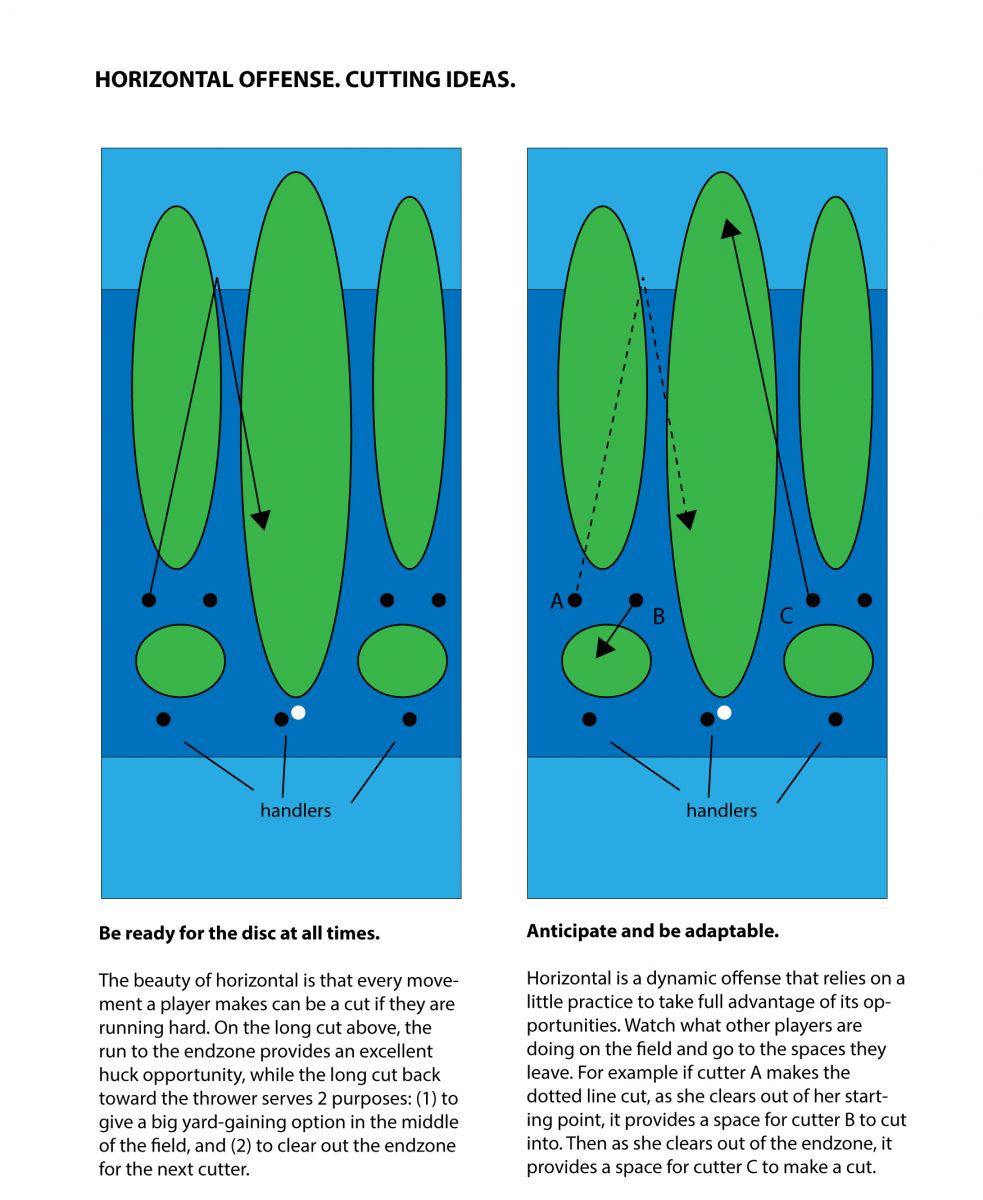Basics of Offense in Ultimate
- Vertical Offense Overview
- How the Vertical Offense is designed to work
- How the Vertical Offense works in game
- Vertical Offense Summary
- Horizontal Offense Overview
- How the Horizontal Offense is designed to work
- How the Horizontal Offense works in game
- Horizontal Offense Summary
Offensive Roles
In general, players will assume one of two roles when playing Ultimate. Before each point starts, team leaders usually specify which players will be handlers and which players will be cutters.
Handlers.jpg)
Handlers are two or three people on the field who are designated to be responsible for throwing and moving the disc. They are often the more seasoned or confident throwers. Generally speaking, if you are a handler you:
- pick up the disc at the beginning of a point, or after a turnover;
- provide a dump option;
- have strong throws to be able to consistently and accurately throw the frisbee up the field to cutters getting open;
- take initiative by identifying the person you want to cut by calling their name or making eye contact (or a code or designated play if your team has them);
- make safe throws to ensure that nobody on the field gets hurt;
- be spirited. Always play with SOTG in mind!
Handler Responsibilities
- Start in the middle. When you start the offense at the beginning of the point or after a turnover, start in the middle so you have more options.
- Throw to the open player. Wait for one of your cutters to get open and throw them the disc – and don’t panic! You’ve got time.
- Dump at 5. If you do not have any cutters open by stall 5, you should begin to look for a dump. Even if you lose a few yards, this is a good play because it resets the stall count and allows your team more time to have an open / easy throw.
- Be the dump. If you are a handler who does not have the disc, you need to be watching the thrower so that you (or the other handler) are available to provide a safe dump option to reset the stall count.
- Make safe throws to ensure that nobody on the field gets hurt.
- Be spirited. Always play with SOTG in mind!
Cutters.jpg)
Cutters are those who do most of the running up and down the field. Their job is to create options for the thrower by cutting to open space and then throwing to the next cutter or a handler once they receive the disc. Creating space for other cutters is as important as getting the disc yourself. Cutters will generally line up in a vertical or horizontal stack.
If you are a cutter you:
- are a strong runner with good cardio fitness;
- create options for your thrower by cutting to open space;
- clear out of the cutting lane in order to make space for the next cutter;
- always sprint when you make a cut. You can rest when you are back in the stack or away from the play;
- make safe cuts to ensure that nobody on the field gets hurt. You should NEVER make a cut that causes contact or risks injuring another player.
- be spirited. Always play with SOTG in mind!
Cutter Responsibilities
- Sprint to get open. Your job is to get open in an area where your handler has a throw they are capable of making. Don’t jog! Be sure you sprint.
- Make sharp ‘V’ shaped cuts. This is very important in order to get open. Most new players make round banana shaped cuts, which makes it very difficult to get open as your defender will easily follow you. See the diagram below for examples of good cuts and bad cuts.
- Don’t give up on your cuts. This is especially true if you are making a deep cut to the endzone – this can be a long run, but commit to the long run before clearing out and returning to the stack.
- Sprint to clear out. As soon as you realize you are not going to get the disc, clear out by sprinting back to the stack. This will open the cutting lane so a second person can cut.
- Watch your teammates. Don’t cut to the same side or at the same time as one of your teammates. This can clog up the cutting lane and make it more difficult for the thrower. If your teammate is not clearing out though, take initiative and yell to clear out while making your cut to their space.
- Time your cuts. If you see that one of your teammates is open and going to catch a pass, try to time a cut so you are open when they catch the disc and have someone to throw to right away. Ideally, you shouldn’t wait until your teammate catches the disc to start your cut.
- Rest in the stack. If you are tired, rest in the stack. Never rest or jog in the cutting lane.
- Adjust the stack. If the disc swings to the other side of the field, make sure you and the rest of the stack adjust to clear out that side of the field so a cutter can get open, as that becomes the new cutting lane
- Make safe cuts to ensure that nobody on the field gets hurt. You should NEVER make a cut that causes contact or risks injuring another player.
- Be spirited. Always play with SOTG in mind!
Offensive Strategies
With 14 players on the field at all times, Ultimate games can sometimes look like complete chaos – and often they are! Playing a structured offense:
- helps eliminate confusion;
- gives players specific roles;
- creates open space for other cutters;
- keeps the playing field as safe as possible;
- helps prevent clogging.
The two most commonly used offenses in Ultimate are vertical offense and horizontal offense.
Vertical offense has a straight-forward structure that is easy for new players to learn. It is also easily adapted by teams to create more sophisticated offensive plays.
Vertical Offense Overview
Vertical offense typically comprises of 2 handlers and 5 cutters. You’ll mostly set up in vertical at the beginning of a point or after a turnover. The first player in the vertical stack stands 5-10 yards from the handler with the disc, while the other cutters stand in a vertical line behind that first player; there should be about 3 yards between each person in the stack. The other handler should stay out of the way of the play, on what we call the break side. This will allow cutting lanes to remain open for all the cutters in the stack.
The following graphic will give you a better understanding:
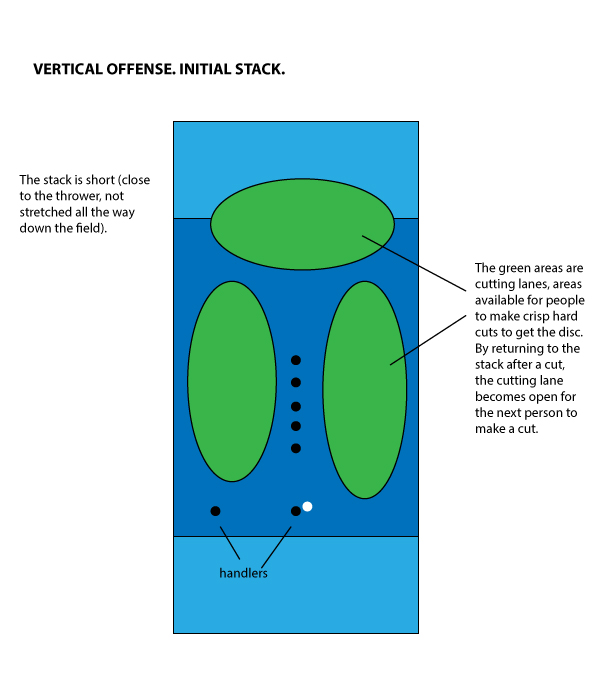
How the Vertical Offense is designed to work
The goal is to move the disc down one side of the field. When that starts happening, the stack should adjust to create more space on that side by swinging the back of the stack over to the opposite side of the field. Once momentum down that side stops because there are no longer open cutters , the new goal is to re-set the disc to a handler in the centre of the field and the vertical stack returns to the centre in order to create more options again. Remember to always make safe cuts that avoid risking injury to you or other players!
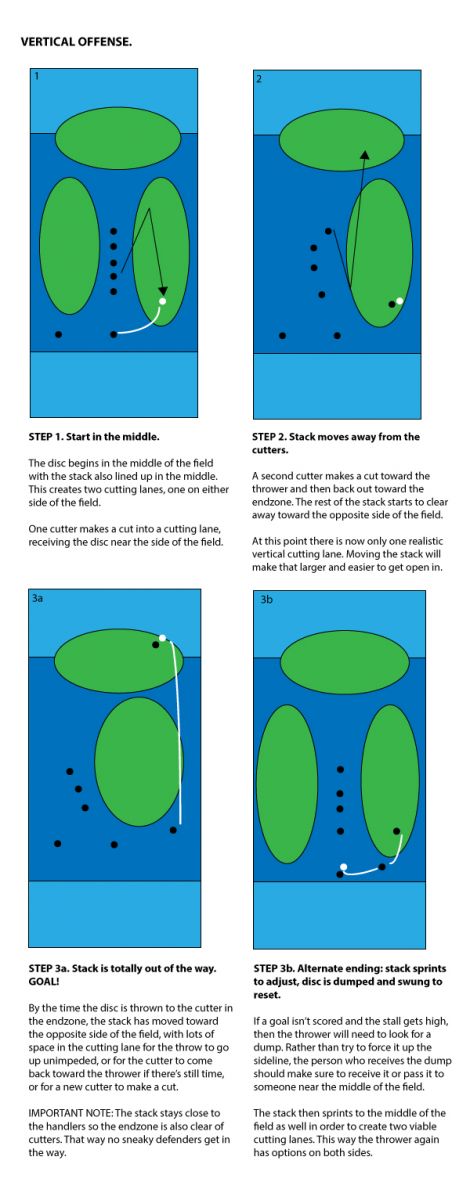
How the Vertical Offense works in game
In reality, it’s often messier than that. Cutters don’t always get open and throwers don’t always feel like they can throw the throw that’s needed. That’s why at about stall 5, throwers need to stop looking upfield and make the decision to dump it to one of the handlers. This is a handler responsibility: they need to get open promptly for these critical dump passes in order to reset the play. The stack adjusts to the new handler getting the disc and the person who threw the dump clears out and gets back into the stack – unless the person who threw the dump was a handler, who returns to the break side handling position.
At the end of the day it’s about being able to adapt on the fly, communicate with your teammates, and keep working hard to make the play happen.
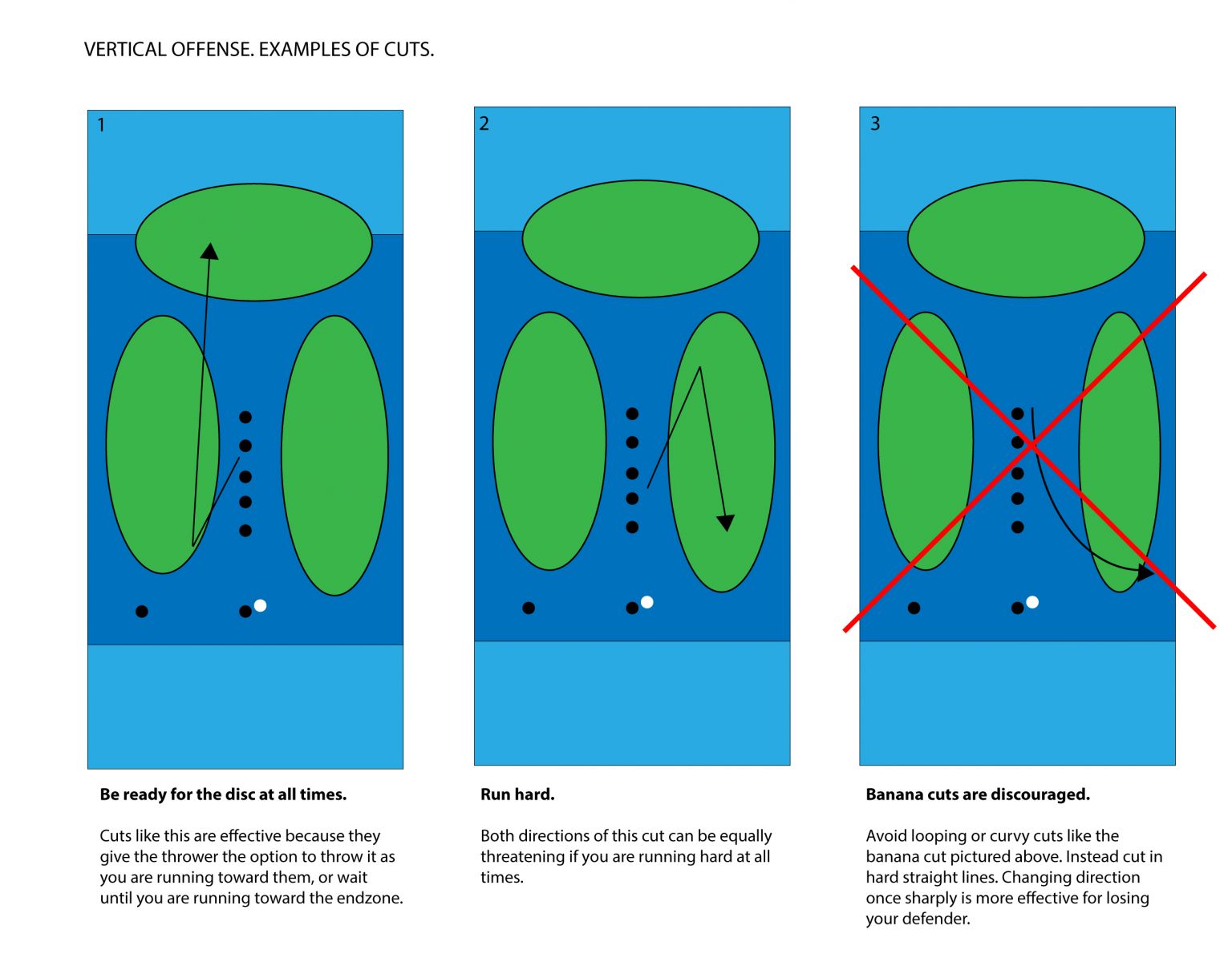
Vertical Offense Summary
There are a lot of moving pieces and many things to remember. You should read this page over and over as you continue playing, putting the skills into practice. When everyone on your team works together to advance the disc, it looks like a well conducted orchestra. For a moving graphic of what vertical can look like, check out this video explaining how it works in basic animation.
If your team has throwers who can consistently throw long passes down the length of the field (called hucks) then the horizontal offense can be an excellent strategy, as it is designed to provide plenty of both long and short throwing options.
Horizontal Offense Overview
Horizontal offense is structured to create space in the middle of the field, unlike vertical which looks for space (or cutting lanes) down the sides of the field.
There are three handlers that line up horizontally across the field. The middle handler should be close to the centre of the field and have a handler 10 to 15 yards on either side of them.
The four cutters are 10 to 15 yards downfield from the handlers; two on each side of the field.
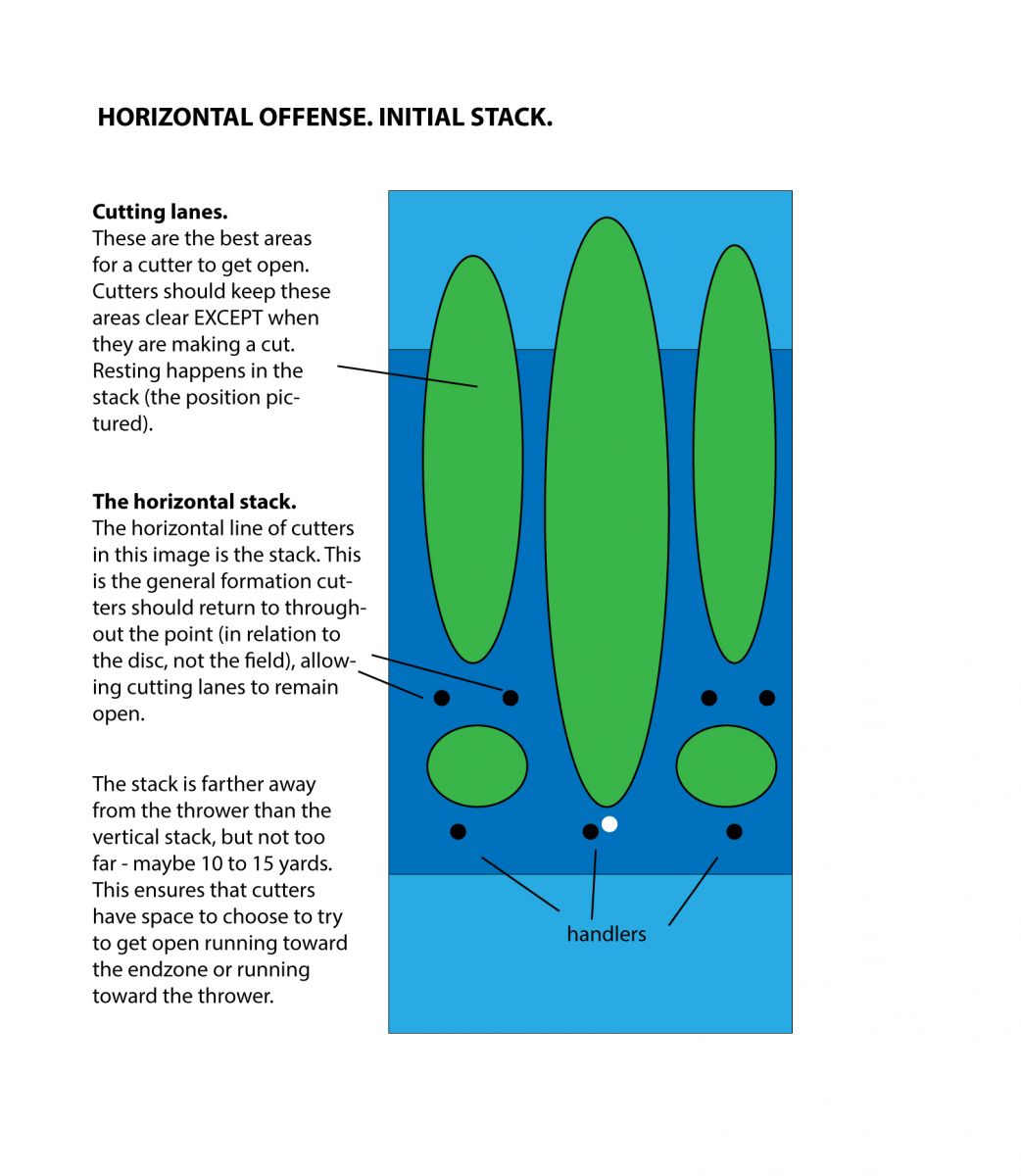
How the Horizontal Offense is designed to work
In horizontal two or more people can be making cuts at once, and if the cuts are effective this can create two or more viable options for the thrower. Assuming handlers have the ability to throw all of the throws, a team can truly take advantage of whatever the defense is not defending effectively. Remember to always make safe cuts that avoid risking injury to you or other players!
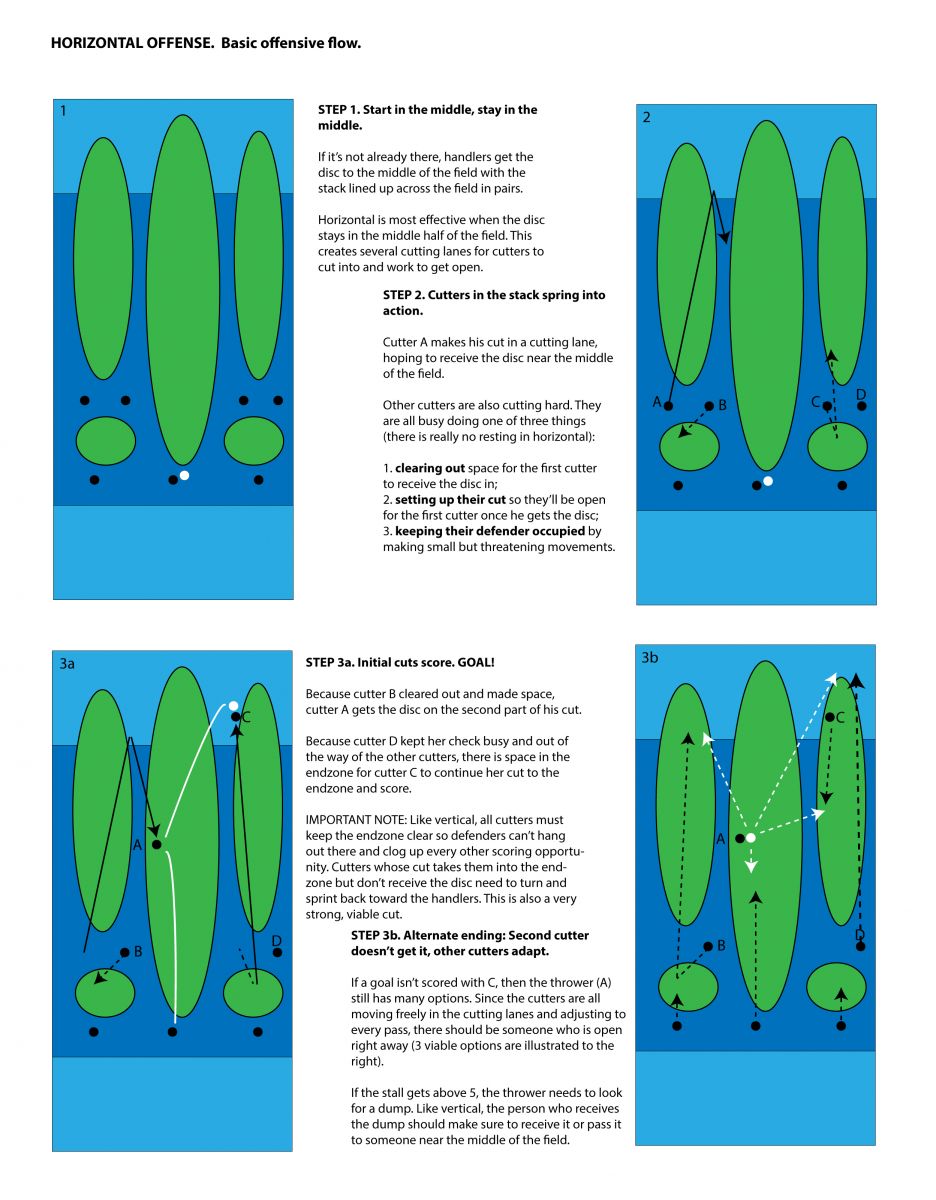
Horizontal Offense In Game
In reality horizontal offense can look messy. But horizontal has the advantage of being more easily adapted, since it is designed to create two or more viable options for the thrower at all times. There is more space for cutters to continue to cut even if their first one doesn’t work out, so in theory there should always be someone open (or nearly open) even when the disc gets passed around a little by the handlers.
Again, communication, adaptability and hard work are what makes the difference between a team that wins the tough points and the team that loses them.
Horizontal Offense Summary
There are a lot of moving pieces and many things to remember - even more than in vertical. You’ll likely need to read this over several times as you continue playing to fully understand all the concepts. For a moving graphic of what horizontal can look like, follow the link to the Playspedia.

